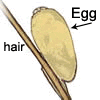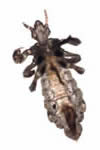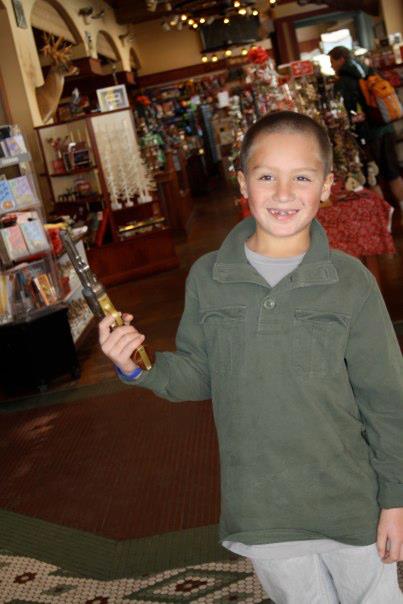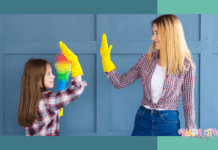We decided to keep the bedroom lights on. Fresh from his shower with a towel still draped around his torso, my husband emerged and stood at the foot of our bed, beads of water clinging to to his bare chest. I’m looking at him, admiring him. But all I can think about is lice.
I was waiting for my husband, anticipating what was about to happen. I was even nervous about it. Reaching into the top drawer of my nightstand, I pulled out a large elastic band and carefully placed it on my head. I flipped on its switch.
“I’m ready,” he said.
I leaned into my husband and began to search...for lice. Parting my husband’s hair and parting it again, I scoured his scalp for any sign of the tiny bugs, like a miner searching for gold.
“Nothing,” I said, pulling off my son’s headlamp tossing it to my husband. “Your turn.”

On this late December night, our bedtime routine had come to this: meticulously searching one another’s head for lice. Lice! Did I mention it was four days before Christmas and I was expecting a house full of guests? It was just two days earlier when, as my twin second-grade son sat at the kitchen table doing his homework, I saw this strange movement at the top of his hairline. It was actually multiple things—little black things—crawling within my baby’s thick head of light brown hair. I shrieked the kind of scream only a mom in sheer panic can produce. I summoned his brother, with whom he shares everything, and his younger sister to the table like a sergeant calls his troops for war.
“You have lice!” I screamed.
I had no prior experience with lice. Having grown up on the East Coast—Delaware, to be specific—I could remember only once hearing about lice. A fifth grader named Kelly was rumored to have had it. Back in 1986, the school nurse lined up every student in every class and combed through our heads. Poor Kelly, no longer known as Kelly but rather “the girl who had lice,” returned to school a few days later with a short, feathered haircut. (It was 1986.)
Now it was my kids—plural—who had lice.
Itch.
I felt embarrassed. Only dirty kids get lice, right?
Scratch.
Actually, when it comes to lice, it is quite the opposite. Head lice prefer clean, short hair. Here are some other basic facts about lice according to the Centers For Disease Control and Prevention:
- In the U.S., infestation (I seriously begin itching at the sound of that word alone!) with head lice is most common among preschool-aged children attending child care, elementary school children, and the household members of infested children.
- Head lice move by crawling; they cannot hop of fly.
- Head-to-head contact puts someone at greatest risk of getting the bugs; the spread of lice by contact with clothing (hats, scarves, coats) or other personal items (brushes, towels) is uncommon.
- Head lice have three forms: nits (eggs), nymphs, and adults.
- Nits are laid at the hair shaft and are oval-shaped. They are about the size of a knot in thread and usually take 8–9 days to hatch.
- A fully grown adult louse is about the size of a sesame seed and tan to grayish-white in color.
- Lice are most commonly found behind the ears and near the neckline at the back of the head. (I have personally always first seen them on the top of the head, near the forehead in my own children.)
- Head lice are most active in the dark. (Sorry to freak you out even more.)
- Pets do not play a role in spread of lice.
- Head lice (and their eggs) soon die if separated from their human host. Adults can live only a day or so off the human head without blood for feeding. Nits generally die within a week away from a human host.
- According to data, head lice can survive for several hours underwater. Chlorine found in pools does not typically kill head lice.



These facts were among the many of which I became obsessed after my three children were found to have lice. I’m not going to lie—I was freaked out. The nasty bugs sent my OCD into high gear, and I was a mom on a mission—first, to kill lice, and second, to make sure neither my husband nor I got them. Here’s something else, too: While I remember feeling embarrassed at finding the lice, I soon learned that it is, disturbingly, a right of passage of sorts, when you live in San Antonio or any other mostly warm southern state.
In my now-lice ridden house, I went into complete haz-mat mode. No kid was to sit on any couch or go near any towel or pillow. I did not want them in their beds or in my room. As I ordered my little infected loves to freeze and stay put, my husband sped off to the nearest pharmacy to pick up our lice arsenal: Rid (dubbed America’s #1 lice brand), new combs, new brushes, so-called lice combs, and a type of lice defense spray (we bought one at our local pharmacy called Lice Shield). At this point, I had read about the concerns over possible dangers in a bug-killing product such as Rid. At the moment, however, I didn’t care. I was focused on killing the things while silently convincing myself that just one week’s use of the stuff can’t be that bad. I bought special fine-tooth “lice” combs (one for each child) and became neurotic over combing through the kids’ hair. Friends who had also been through lice told me that getting every last nit was key. I was determined to do just that.
On day one, I treated all three kids’ hair. This process included applying Rid to kill live bugs, shampooing, and then performing long and tedious comb-throughs. These comb-throughs would usually take place at the kitchen or in the family room because those are two areas where we have a lot of natural light. Also, the kids could watch a movie or show. This went on for six days. For what felt like an eternity, I would section off the hair and carefully run the lice comb from the root of the hair to the ends. Most often, I found nits about one inch from the scalp. With each swipe I would rinse the comb in a bowl of water or clean it with a paper towel, obsessively looking to see how many nits I may have pulled out. And there’s more—perhaps one of the most important things about lice treatment with something like Rid is to repeat the Rid treatment and comb-throughs again seven days after the first treatment!

As the kids sat with Rid on their hair or waited to be combed over and over again, my husband and I bagged every stuffed animal or cloth-covered toy in the house and put them into quarantine in the garage. I washed every blanket, towel, pillow, comforter, and jacket in hot water. I even threw my daughter’s special doll baby with “real people” hair in the dryer for a short cycle, frying her sweet (and expensive) curls beyond recognition. As for my own kids’ locks, well, since the kids themselves were too big to throw into the dryer (I kid), after we had treated their hair my husband gave the twins a good ol’ Texas-style buzz. My daughter got a bob. This made the second round of Rid treatment more doable.
For us, lice fell during our Christmas break. So, whether and when to send them to school was not an issue. According to Lice Doctors, a service that will come to you to treat lice, head lice policies vary from school district to school district. The Texas Department of State Health Services says on its website that no law exists in Texas that addresses excluding children with head lice from school and recommends policies and procedures “should not encourage the embarrassment and isolation of students who suffer.”
To this day it is easy to look at that year’s Christmas photo and be reminded of “the year the kids got lice.”
After the two-week lice treatment, our work was done. It had been successful. We got rid of the lice, and my husband and I remained lice-free throughout the grueling process.
Since our own ’Twas The Night Before Lice experience, several ACMB contributors have gone through lice trials as shared in our team Facebook group. Among the venting and pleas for wine STAT, there was also a ton of great advice shared, including more “natural” ways of treating lice:
- “If one kid gets it, treat them all at the same time.” —Ginger
- “Hairspray! It doesn’t kill lice, but it stops them from attaching to hair.” —Lindsay
- “[Use] lavender and tea tree oil in some very light hair oil post treatment. I sprayed my kids’ hair every morning before school.” —Ginger
- “My friend who is a pediatrician recommends Spinosad. Pricey, and you have to get it from a doctor; however, it apparently kills everything!” —Erin R.
- “After lice twice, we now use lice prevention shampoo and try to wash hair every other day.” —Kristin
- “Fairy Tale comb is the best!” —Bridget
- “Don’t forget the car when sanitizing areas!” —Rosalinda
- “I tried homemade remedies such as rinsing hair with mouthwash to flat ironing hair (heat kills lice), but I think the ongoing head checks (for two to three weeks!) with a lice comb is the way to go.” —America

I also googled “how to get rid of head lice using home remedies” and found suggestions that include vinegar, mayonnaise, coconut oil, onions, and more! You can read more here. In fact, if you google head lice you will find a myriad of solutions that seem to be going away from poison shampoos. I especially liked an article by NPR news that suggested shrink wrapping, zapping, or blowing lice out of hair!
The good news is that lice does seem to affect families when children are young. While researching lice, I came across an article from the Head Lice Center that actually explains this phenomenon. It says children get lice more often than adults due, in part, to scalp pH.
I am happy to be able to back up that theory with anecdotal evidence. Lice have not invaded anyone’s head in my family since my oldests were in elementary school. Perhaps that’s one great thing about aging and watching your kids grow older that often goes unmentioned: Head lice become a thing of the past, along with all those horrid hours you spent trying to eliminate them! Well, mostly horrid. The headlamps my husband and I used to check each other for lice before bed were interesting. I’ll just leave it at that.
Help a parent out! If you’ve had an experience with head lice, please share what worked and what didn’t in the comments below.












Hi Erin,
great informative article!
We also have a detailed article on head lice treatment. If you think that may help your community, it’s here: http://headlicecenter.com/head-lice-treatment-basics/. It answers questions, based on research, such as Do Lice Treatments Work? or What Do Trusted Health Sources Say About Head Lice Treatments?
Cheers,
Anne
Sorry, I typed the wrong web address. It’s http://www.liceclinicsofamerica.com
Please spread the word that there are urgent care lice clinics available nationwide that will treat head lice and their eggs. The treatment uses an FDA cleared medical device that uses controlled heated air to kill lice and their eggs. The treatment only takes an hour, it’s non-toxic and it’s guaranteed. At an average cost of $170, it’s well worth your time and money! Your child will even be given a certificate to give to the school certifying they are lice free.
http://www.liceclinicsoramerica.com